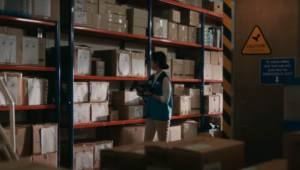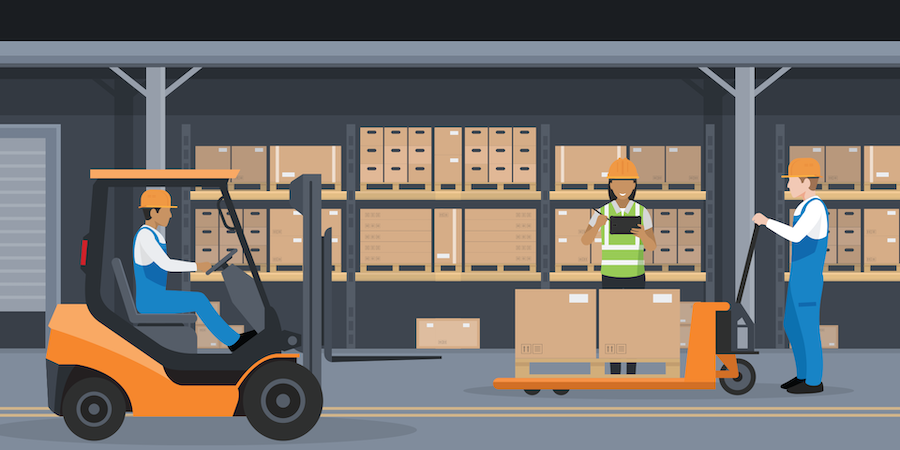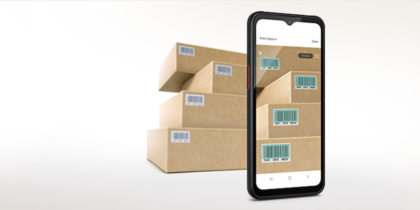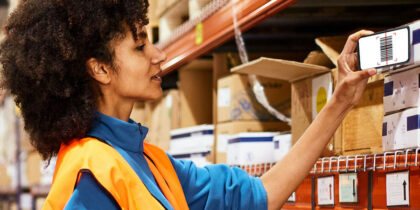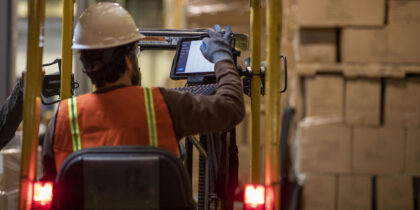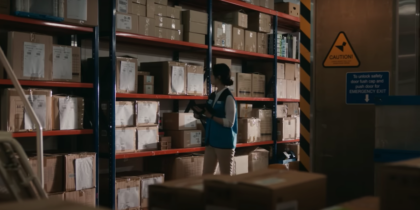The year 2020 was tough for many sectors — but not for supply chain. Fueled by e-commerce growth of 44 percent year over year, supply chain played a critical role in keeping retailers afloat while following social distancing guidelines. Retailers, merchants, delivery teams and logistics providers who invested in digital technology were ready to support the surge in online demand. But the companies that weren’t prepared faced significant losses. Looking forward, some of the trends established during the pandemic will remain for years to come. As e-commerce continues to grow, convenient services such as next-day delivery, curbside, drive-thru and on-site retail returns will become the standard.
To support these services, supply chain processes must be fully integrated and efficient, with real-time visibility into operations. Mobile technology can streamline these processes by digitizing paper-based workflows and integrating with legacy enterprise resource planning (ERP) systems to track the supply chain every step of the way — optimizing routes, workflows and asset maintenance. What’s more, mobile solutions can help transportation teams adhere to regulations, verify customer deliveries and boost retention of critical employees.
The year 2021 is likely to see more companies than ever investing in mobile technology. International Data Corporation (IDC) projects that, in 2021, the technology industry is on pace to reach $5 trillion worldwide. This would represent 4.2 percent growth, returning the industry to its prepandemic rate.
When it comes to supply chain optimization, the most prevalent trends include:
- Sunsetting of legacy 3G products
- Digitizing paper-based processes in the supply chain
- Supply chain solutions moving to the cloud
- Internet of things (IoT) and 5G
- Automated delivery
- Optimizing supply chain using AI and camera technology
- Voice and AR-guided pick and pack
- Social distancing and contact tracing in distribution centers
- Improved work from home (WFH) experiences
1. Sunsetting of legacy 3G products
With the emergence of 5G, supply chain professionals have the potential to connect thousands of IoT devices on a unified platform — elevating their mobile logistics workflows and supporting mission-critical communications. But about 7.5 million legacy 3G devices still need to be upgraded, which presents a challenge for many companies in the supply chain sector. 3G slows down transactions, as well as communication to the field team, and makes it more difficult for IT to manage mobile devices. It’s time to migrate from proprietary 3G devices to an open mobile platform that supports 4G and 5G.
The definitive guide to warehouse efficiency
Get your free guide to increasing warehouse efficiencies and cutting costs with mobile processes. Download Now
“An important first step is for fleets to educate themselves on what the 2G and 3G sunsets are all about, including why wireless carriers are making this change to pave the way for more advanced networks and increased connectivity,” says John Binder, director of wireless operations for Trimble Transportation. “It is also important for fleets to evaluate which devices in their vehicle base will be impacted by these sunsets and what action is required.”
While most consumers are already using 4G — or even 5G — on their personal devices, many business fleets have yet to make the transition.
According to John Nichols, executive vice president of sales for North America at Mix Telematics, about 80 percent of his customers are still using 3G devices. Mix Telematics has been actively converting these fleets over the last year or so, but the pandemic slowed their progress. “We continue to work closely with our customers and cellular provider to look at ways to make up for lost time due to COVID-19,” says Nichols.
2. Digitizing paper-based processes in the supply chain
The industry has reaped major benefits since the Federal Motor Carrier Safety Administration (FMCSA) implemented regulations for electronic logging devices (ELDs) in 2018 and 2019. Log books that were difficult to maintain and keep track of were replaced with mobile apps. In distribution centers and warehouses, manual data entry has a lot of room of error, which can majorly disrupt the supply chain process. Converting these workflows, including forms and photos, into a digital platform can improve communication, increase overall efficiency and reduce the risk of error.
3. Supply chain solutions moving to the cloud
Just as 3G is being replaced, apps that are on-site, custom or hardware-dependent are being replaced by more cloud-based solutions. Enterprises can use cloud-based solutions to improve their system and app performance, shorten implementation timelines and unify multiple third-party apps. Mobile solutions based in the cloud are easier to manage, and they eliminate the ongoing maintenance cost associated with custom software.
- Gartner had projected that by 2020, over 90 percent of spending on supply chain execution systems will be for cloud supply chain solutions.
- By 2023, talent shortages in the supply chain for 75 percent of the top 500 manufacturers worldwide will mostly have been mitigated by the use of supply chain digital assistants.
- Cloud-based supply chain management software solutions are set to surpass $11 billion by 2023.
- The market for cloud supply chain management software was expected to rise by at least 24 percent in 2020.
- SaaS revenue as a whole is expected to exceed $307 billion by 2024.
4. IoT and 5G
In realizing the full potential of IoT devices, 5G is the sturdy foundation. Supply chain companies can seamlessly link a dozens — if not hundreds — of embedded sensors in a unified 5G-supported network, gathering real-time data, instantly communicating with team members, controlling machinery and tracking assets moment by moment. As they implement 5G and IoT solutions, supply chain companies can deploy new services, such as guided augmented reality (AR), which can assist with delivery routes or processes within a distribution center.
Qualcomm president Cristiano Amon says the growing popularity of 5G is transforming the global economy. “Among policymakers there is a broad understanding now that not having 5G would lead to an uncompetitive economy, as we go to the next transition of the digital economy that relies on three elements — 5G, artificial intelligence and cloud,” explains Amon. “We’re in just the beginning of a new 5G-enabled economy. And that’s just looking at existing use cases. But the reality is, most of the use cases are not yet invented.”
5. Automated delivery
As delivery services improve and next-day or even same-day deliveries become the norm, companies are investing in automated technology specifically for autonomous delivery. With many or even most customers living within a few miles of the store they ordered from, there is a growing market for on-demand, hyper-local delivery services. Delivery companies such as FedEx, Amazon and UPS are now heavily invested in unmanned delivery bots and drones, which offer rapid delivery for small packages, for homes and businesses alike. These bots and drones are enabled by machine learning and 5G connectivity, servicing customers safely and efficiently.
6. Optimizing supply chain using AR and camera technology
As e-commerce continues to grow, so does the risk of fraud. Supply chain companies that work with high-valued goods retailers know that fraud is an inevitable liability, but mobile technology can all but eliminate that risk. With improved camera recognition on smartphones, AI and AR are now able to determine if a branded product is authentic.
7. Voice and AR-guided picking and packing
High employee turnover is a major challenge in the supply chain. Companies have to train and support new hires quickly to avoid disrupting delivery timelines. Voice and AR guidance have been proven to improve order accuracy by over 99 percent, accelerate fulfillment timelines and speed up training, even in loud and harsh environments.
Supply chain companies can provide employees additional support by developing guidance for using AR in distribution centers, visually showing associates on where to pick and place products.
8. Social distancing and contact tracing
In massive distribution centers, viruses spread quickly, due to the large number of employees and their close proximity. Companies can implement mobile tools like Galaxy watches to alert employees when they get too close to each other. And if someone gets sick, these tools can track their interactions so that those who may have been exposed can be advised to quarantine.
9. Improved WFH experiences
Many companies have implemented remote work strategies, even offering WFH as a permanent option for the foreseeable future. Employees may spend less time in traffic, but WFH may also lower productivity if employees’ home internet is slow, video calls are low-quality or your business software isn’t mobile-friendly. When you create a fully mobile WFH experience, remote team members can work effectively from anywhere with access to critical applications and easy communication with their coworkers.
Consider which of Samsung’s rugged mobile devices best suits your team’s needs. And as you work to take your warehouse operations fully mobile, make sure you read our guide on optimizing processes and cutting costs.


